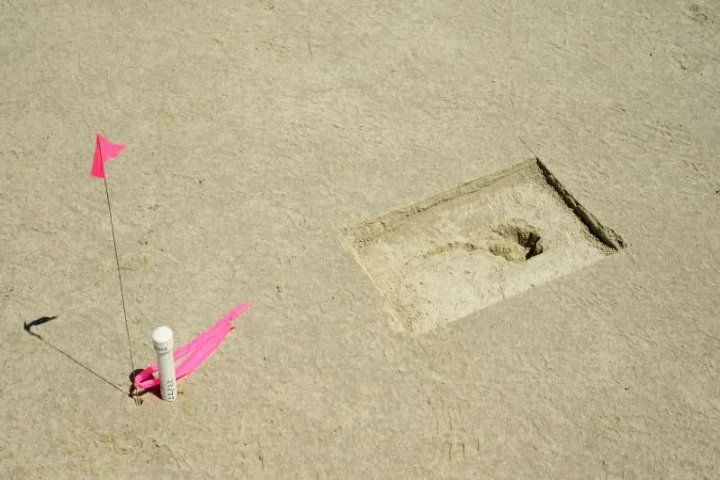

A footprint discovered at the Utah Test and Training Range (Pic. Courtesy smithsonianmag.com)
<p>
<strong>Finding something extraordinary in a place where it is least or not expected gives immense thrill. This is what transpired when researchers travelling in a Utah desert in the US came across human footprints that were thousands of years old!</strong></p>
<p>
Sharing details about this find, a report in smithsonianmag.com stated that Thomas Urban, a research scientist with the Cornell Tree-Ring Laboratory while going to an archaeological site on Utah&rsquo;s Air Force base saw tracks on the ground. Inquisitive, he along with his companion Daron Duke, an archaeologist stopped. Looking carefully, they found them to be bare human footprints preserved in the desert salt flat.</p>
<p>
Recalling the incident for New York Times, Urban said: <a href="https://www.smithsonianmag.com/smart-news/archaeologists-find-12000-year-old-human-footprints-in-utah-180980526/?utm_source=smithsoniandaily&amp;utm_medium=email&amp;utm_campaign=20220804-daily-responsive&amp;spMailingID=47196279&amp;spUserID=MTI4MDgxMTczNjcwMgS2&amp;spJobID=2300399293&amp;spReportId=MjMwMDM5OTI5MwS2">&ldquo;When I spotted them from the moving</a> vehicle, I didn&rsquo;t know they were human. I did know they were footprints, however, because they were in an evenly spaced, alternating sequence&mdash;a track pattern.&rdquo;</p>
<p>
Earlier Urban had investigated the ancient human &ldquo;ghost tracks&rdquo; which are imprints that take shape when the moisture conditions are appropriate while they vanish in the sun. These prints were in White Sands National Park in New Mexico. Along with other scientists he had developed a method to record the prints using ground-penetrating radar.</p>
<p>
The next day, the researchers returned to the hidden tracks to check the feasibility of a GPR survey to locate more prints.</p>
<p>
In a statement Cornell said: &ldquo;As was the case at White Sands, the visible ghost tracks were just part of the story. We detected many more invisible prints by radar.&rdquo;</p>
<p>
In all 88 individual footprints consisting of both adults and children were detected.</p>
<p>
What made this discovery amazing was the fact that human beings hadn&rsquo;t lived in this region for thousands of years and at present it was a desert military training site. This led the researchers to the &ldquo;most logical explanation&rdquo; &ndash; these footprints came into being around 12,000 years ago when it was the late Pleistocene period.</p>
<p>
During this said period, there was water in the Great Salt Lake Desert in Utah just like the way it is found in Great Salt Lake located nearby. When nearing the end of the last ice age, the lake started drying up, and people occupied the wetland for a brief time. The wetland phase existed for 10,000 years and the conditions during this timeframe were apt for making these footprints.</p>
<p>
Explaining this in a statement, Duke, an archaeologist with the Far Western Anthropological Research Group said: &ldquo;People appear to have been walking in shallow water, the sand rapidly infilling their print behind them &ndash; much as you might experience on a beach &ndash; but under the sand was a layer of mud that kept the print intact after infilling.&rdquo;</p>
<p>
Going further, the scientists want to now pinpoint the date when these prints were created and hunt for more clues to know more about these people who left them and their lives.</p>
<p>
Summing up this study, Urban said: &ldquo;We have long wondered whether other sites like White Sands were out there, and whether ground-penetrating radar would be effective for imaging footprints at locations other than White Sands, since it was a very novel application of the technology. The answer to both questions is &lsquo;yes&rsquo;.&rdquo;</p>
By Shalini Bhardwaj A government-appointed expert committee in Karnataka has found no evidence linking COVID-19…
BRICS leaders convened in Rio de Janeiro for the 17th BRICS Summit from July 6…
Vietnam's Ambassador to India, Nguyen Thanh Hai, highlighted the strong cooperation between Vietnam and India,…
Leaders of the BRICS nations welcomed Indonesia as a member of the group, while 10…
External Affairs Minister S Jaishankar held a meeting with his Russian counterpart Sergey Lavrov on…
The Russian military has carried out a series of strikes on Ukrainian military-related targets in…